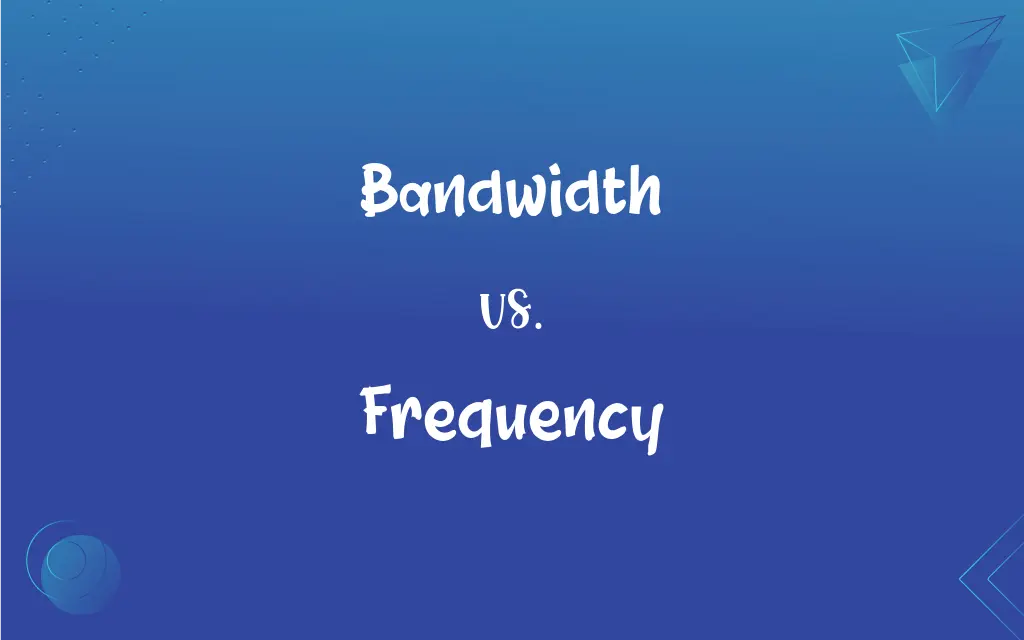Bandwidth vs. Frequency: What's the Difference?
Edited by Janet White || By Harlon Moss || Updated on October 19, 2023
Bandwidth refers to the range of frequencies in a signal; frequency is the rate at which a signal oscillates.

Key Differences
In communication systems, both bandwidth and frequency play crucial roles, yet they serve distinct purposes. Bandwidth is a measure of the range of frequencies over which a system can operate effectively. It quantifies how much data can be sent through a network or a channel, usually expressed in terms of Hertz (Hz) or bits per second (bps). Conversely, frequency denotes the rate at which a signal or wave oscillates in a given period. It's expressed in Hertz (Hz) and determines how often a signal completes one full cycle.
For instance, when discussing radio signals, bandwidth might describe the span of frequencies allotted to a radio station, while frequency will refer to the specific central frequency at which the station transmits.
From a broader perspective, bandwidth can be seen as the width of a channel on the frequency spectrum. In contrast, frequency is a specific point or location within that spectrum.
While bandwidth can give an idea of the capacity or space available for data transfer, frequency is more about the position and repetitive nature of a signal.
Comparison Chart
Definition
Range of frequencies over which a system operates.
Rate at which a signal oscillates.
ADVERTISEMENT
Units
Hertz (Hz) or bits per second (bps).
Hertz (Hz).
Role in Communication
Determines data transfer capacity.
Specifies the signal's position on the frequency spectrum.
In Radio Transmission
Span of frequencies allotted to a station.
Specific central frequency at which a station transmits.
Concept
Width of a channel on the frequency spectrum.
Specific point or location within the spectrum.
Bandwidth and Frequency Definitions
Bandwidth
The difference between the upper and lower frequencies in a continuous set of frequencies.
The audio recording has a bandwidth spanning from 20 Hz to 20 kHz.
ADVERTISEMENT
Frequency
The number of times a signal oscillates per second.
The frequency of the radio station is 100.5 MHz.
Bandwidth
The range of frequencies a system can handle.
The radio station has a bandwidth of 200 kHz.
Frequency
The rate at which something occurs over a particular period.
The frequency of these earthquakes is alarming.
Bandwidth
The capacity of a communication link to transmit data.
With high bandwidth, video streaming becomes smoother.
Frequency
A specific position in the electromagnetic spectrum.
Radio waves have a lower frequency than gamma rays.
Bandwidth
A measure of the width of the frequency range used by a signal.
The bandwidth of the Wi-Fi signal is 40 MHz.
Frequency
The number of complete cycles of a wave occurring in a unit of time.
The frequency of the AC current in the U.S. is 60 Hz.
Bandwidth
The amount of data that can be transmitted in a fixed amount of time.
Fiber-optic cables offer greater bandwidth than traditional copper cables.
Frequency
The regularity or repetition rate of an event.
The frequency of her visits has increased recently.
Frequency
The property or condition of occurring at frequent intervals.
Frequency
The number of repetitions of a complete sequence of values of a periodic function per unit variation of an independent variable.
FAQs
Is bandwidth the same as speed?
No, bandwidth is the maximum data transfer rate, while speed is the actual data transfer rate.
How is frequency related to wavelength?
Frequency is inversely proportional to wavelength; as frequency increases, wavelength decreases.
What does bandwidth refer to in networking?
Bandwidth refers to the data transfer capacity of a network, often measured in bps.
Can two radio stations operate on the same frequency?
Not within the same area, as it would cause interference.
Can bandwidth change over time?
Yes, available bandwidth can fluctuate based on network conditions and usage.
How can I maximize my bandwidth usage?
Limiting background applications, using wired connections, and upgrading hardware can help maximize bandwidth.
How is frequency measured?
Frequency is measured in Hertz (Hz), representing oscillations per second.
Why is bandwidth important in internet connections?
Higher bandwidth allows more data to be transmitted simultaneously, leading to faster internet speeds.
Does a higher frequency signal travel farther?
Not necessarily; higher frequency signals can provide more data but might have shorter range due to attenuation.
How does increasing bandwidth affect data transfer?
Increasing bandwidth allows more data to be transmitted simultaneously, improving transfer rates.
Is there a limit to frequency ranges?
While there's no theoretical limit, practical applications and technology set bounds on usable frequencies.
How are bandwidth and frequency related in radio transmissions?
Bandwidth determines the range of frequencies a station can use, while frequency specifies its central broadcasting point.
Can bandwidth be reserved or prioritized?
Yes, in many networks, bandwidth can be allocated or prioritized for specific applications.
Why is frequency important in wireless communication?
Different frequencies can penetrate obstacles differently and carry varying amounts of data.
Can a device's bandwidth be upgraded?
Yes, through hardware or network upgrades, a device's bandwidth can often be increased.
Are higher frequency waves more dangerous?
Some very high-frequency waves, like X-rays, can be harmful due to their energy levels.
Does more bandwidth mean better quality for media streaming?
Often, yes; more bandwidth can support higher quality streams without buffering.
How does frequency affect sound waves?
In sound, frequency determines pitch; higher frequencies sound higher, and lower frequencies sound deeper.
Can a system have high bandwidth but low frequency?
Yes, a system can have a wide range of frequencies (high bandwidth) centered around a low specific frequency.
Do all devices operate at the same frequency?
No, devices operate at different frequencies based on their design and intended use.
About Author
Written by
Harlon MossHarlon is a seasoned quality moderator and accomplished content writer for Difference Wiki. An alumnus of the prestigious University of California, he earned his degree in Computer Science. Leveraging his academic background, Harlon brings a meticulous and informed perspective to his work, ensuring content accuracy and excellence.
Edited by
Janet WhiteJanet White has been an esteemed writer and blogger for Difference Wiki. Holding a Master's degree in Science and Medical Journalism from the prestigious Boston University, she has consistently demonstrated her expertise and passion for her field. When she's not immersed in her work, Janet relishes her time exercising, delving into a good book, and cherishing moments with friends and family.































































